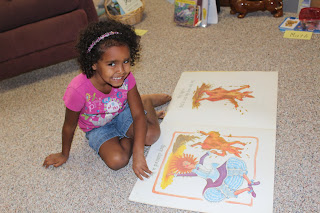Yesterday I spent time in a fifth grade classroom during their reading time. After talking to their teacher about what was happening in the room, she asked if I wanted to do a read aloud/think aloud with the class. She knows me really well because I never can turn down a chance to read to kids! It had been a long time since I have had that opportunity, so I jumped at this experience.
She had planned on reading the book
Mr. Peabody's Apples by Madonna. It was one that I had read many times, so it was not a problem to know when to stop and talk in special places. I also knew I wanted to not only share the books message, but to see how the students did with talking about their thinking.
The teacher and I did an introduction and even read Madonna's dedication at the back of the book. I read. We stopped and they turned to partners and talked. They were seated in a circle on the floor of their gathering area. After talking to their partners they then shared with the whole group. The children understood the meaning of the book and could tell you the moral of the story along with the theme. Normally, I would be satisfied with how the discussion progressed. However, with the idea of Common Core State Standards, students need to do more than that. They need to carry on the discussion with only a little push from the teacher/facilitator.
First of all, the students would look at me rather than at each other when they shared their ideas. I did talk to them about speaking to the whole group, but it didn't really sink in with them. They didn't understand they were to have a discussion with the whole group. What they need next is to see how strong communicators use signals to talk to one another during a discussion. When we talk in groups such as at family gatherings we signal with our eyes, nod our heads, or join in at a pause. When two people start to talk at the same time, one of us knows to wait and listen.
To allow them to learn this skill I am going to suggest a game for the teacher to try. Here is how it goes: Have everyone in the class count from one to how ever many students there are in the class. They will not be assigned a number or raise their hands. They are allowed to only say ONE number.
The teacher would start by saying number one! Then another person will say tow and another will say three. They can only say a number once. If more than one person says a number, they must figure out a way...without speaking...to go on. If they can't decide who goes next, then the game starts again. The game ends when they have counted from one to the end number.
When the game has been played through one time, ask the students to do it again. This time ask them to watch and think about what is happening. What signals or moves do people make to let you know who wants to talk? Be specific. The students should NOT go in the same order as before!
When they are done have them talk about how they figured out when they could say the next number. Make a two column chart: BODY SIGNALS.......HOW THOSE SIGNALS HELPED.
After the game, do the think aloud for the day. When it is time to discuss, say, "What are you thinking?" They can then use the body signals to keep the discussion going!

























